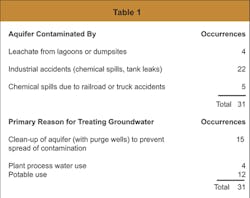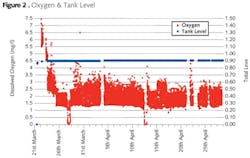Activated Carbon Treatment, Reactivation Help Companies Achieve Regulatory Compliance
Industrial companies are always looking for more efficient and effective ways to treat process wastewater streams and groundwater for the removal of a wide range of organic contaminants to meet current rules and anticipate future regulations. Treatment with granular activated carbon followed by reactivation and recycle offers a cost-effective way to deal with many of today’s challenges while ensuring regulatory compliance.
The technology of adsorption using activated carbon has been used for several decades in environmental applications. Results obtained from 31 operating plants that employed activated carbon to remove toxic compounds from groundwater supplies demonstrate effective performance in a variety of scenarios.
The adsorption systems treated contaminated flows ranging from 5 to 2,250 gpm, with causes of contamination comprised of leachate from lagoons and dumpsites, industrial accidents and spills, and spills resulting from railroad or truck accidents. In 15 cases, activated carbon treatment was used to prevent the spread of contamination through an aquifer, 12 more carbon systems were used for the purification of potable water, and four were used for the decontamination of plant process water.
Data collected from these treatment systems show the ability of activated carbon to remove a wide range of organic compounds from the water streams. Table 2 lists the organic compounds found in the studied groundwater supplies, along with their influent and effluent concentrations.
Most groundwater applications call for the removal of contaminants with concentrations ranging from the low ppm (mg/L) or ppb (μg/L) range. The ability of activated carbon to remove both low and high concentrations of organics is an important consideration. Despite the fact that the types and concentrations of the organics varied by location, treatment with activated carbon consistently reduced contaminant levels to below detectable limits.
One of the most critical design parameters for any adsorption system is contact time – the length of time that contaminated water is in intimate contact with the activated carbon. This important design parameter is generally expressed as “superficial contact time” or the volume occupied by the activated carbon divided by the water flow rate. Longer contact times are usually required as the type of organic compounds increase in number and concentration, and approach the mg/L range. To improve carbon efficiency where longer contact times are required, two or more adsorbers are usually connected in series.
Of 19 systems treating groundwater with organic contaminants at mg/L levels, 16 employed two or more beds in series. Successful treatment was accomplished with total superficial contact times as low as 16 minutes. For systems treating groundwater with organic contaminant levels in the ug/l levels, most of the systems employed two or more carbon beds in series and superficial contact times were as low as 12 minutes.
Reactivation
Total treatment costs associated with activated carbon adsorption can be optimized with reactivation and subsequent re-use. Reactivation, either on- or off-site, represents a strategy that can significantly reduce overall treatment costs for the end user, while helping to greatly reduce the potential for pollutants released to the environment.
Reactivation is a high temperature thermal process, and more efficient in restoring the activity of spent carbon than alternate regeneration processes. The spent activated carbon is removed from the user’s treatment system and processed in a controlled atmosphere with low oxygen content, using steam as a selected oxidant. The adsorbed organics are either displaced from the activated carbon and destroyed or reduced to a carbon char that becomes part of the individual particle structure. The volatile organics are destroyed in the furnace’s afterburner and acid gases are removed by means of a chemical scrubber. The high temperature reaction with steam restores the adsorptive capacity of the activated carbon.
Through reactivation, spent carbon can be recycled for reuse, eliminating the costs and/or long-term liability associated with alternate disposal methods such as incineration or landfill. Reactivation takes what was once a waste product with potential liability and turns it into a recoverable, re-useable asset.
Reactivated carbon costs are typically 70-80 percent of the cost for new, virgin carbon. Reactivation also results in an 80 percent reduction of the greenhouse gases generated when compared to new carbon production.
Consequently, off-site reactivation using a third party reactivation company or, if justified, dedicated on-site facilities should be a serious consideration for industrial companies using activated carbon in point source, plant outfall or remediation applications.
Operating costs associated with activated carbon treatment are dependent on a number of factors including flow rates, contaminant types and concentrations, type of application (potable or industrial), site requirements, timing requirements, and length of the processing project. These factors define the exact equipment, carbon, and reactivation needs required by each individual user. Consequently, estimates of carbon usage and costs can vary widely depending upon specific applications, but some overall observations can be made.
The operating cost for activated carbon treatment is typically lower for applications with lower average influent levels of contaminants. Treatment costs for applications with influent concentrations on a part per billion level installed on a permanent basis can be as low as $0.25/1,000 gallons, with a median value of approximately $0.60/1,000 gallons. Operating costs for facilities with influent concentrations in the part per million range and installed on a permanent basis can be as low as $0.50/1,000 gallons with a median value of approximately $1.10/1,000 gallons.


